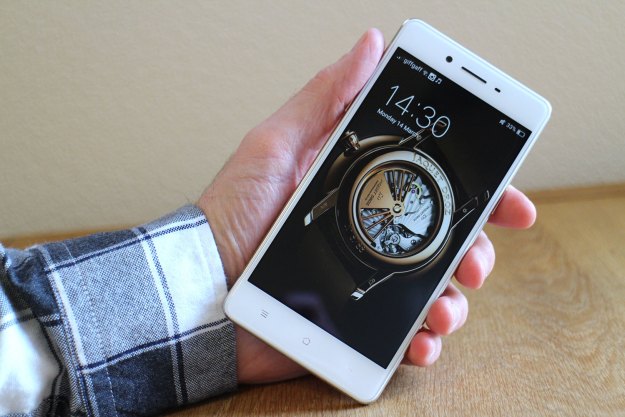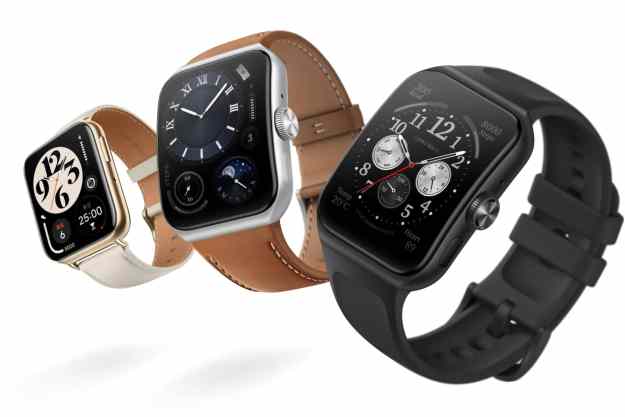
“Oppo’s F1 has superb selfie skills, but its software is a mess and you can’t use it in the States.”
- Excellent selfie camera
- Strong performance
- Low price
- Beautiful, well-built metal body
- Android UI disappoints
- Short battery life
- No official U.S. network support
- No fingerprint sensor
- Rear camera software needs tweaking
If a selfie stick never leaves your side, and your Instagram feed is filled with pictures of your own face, then a smartphone with an excellent front-facing camera will be high on your to-buy list. What was once a niche requirement is way more sought after today, and almost every smartphone will take decent selfies. Oppo says its new F1 phone is a selfie expert and its face-snapping abilities are the main reason to pick up the sleek device.
With so many great selfie-focused smartphones out there, the Oppo F1’s camera needs to be pretty amazing to standout, and you’ll want to know if the device is worth buying in the first place. We have spent time with the phone to see if it’s up to snuff.
Make yourself beautiful
Front-facing cameras on smartphones used to be an after thought, but now that selfies are in vogue, the front shooter is equally important. Oppo focused on making the best selfie camera in the world, and that effort shows.
The F1’s 8-megapixel front camera does an amazing job of making you look prettier, younger, and like you’ve had a full night’s sleep. The camera has a typical beautify mode with three different settings — weak, medium, and strong. The midway point produces the best effect, in our opinion. It smooths everything out, balances skin tone, brightens eyes, and minimizes shadow to create a selfie that’s still you — not some alien imposter pretending to be you. The result is just a bit more attractive than how you actually look in real life.
The F1’s 8-megapixel front camera does an amazing job of making you look prettier, younger, and well rested.
Oppo borrows gesture controls from other smartphones, so that you can snap a selfie with a gesture instead of tapping a button, or activate the shutter by saying “cheese.” The gesture was much more useful, and it actually worked nearly every time we tried it, but the voice activation didn’t activate the camera consistently.
The large quarter-inch sensor and f/2.0 aperture help suck in more light and detail, and there’s a screen flash mode that cleverly assesses the amount of available light, then adjusts the brightness of the screen accordingly. It works surprisingly well. You’re just going to have to trust me, because the selfies I’ve taken to test the F1 (and it’s more than I’ve taken in my whole life up to this point combined) aren’t going to be published without a fight. Sorry.
Rear cam can’t keep up
If the front camera is the F1’s big feature, its back camera should be just as good. On paper, it certainly sounds like a strong performer. The back camera on the F1 sports a 13-megapixel sensor, phase-detection autofocus, some anti-shake trickery, and a host of Oppo features. However, the f/2.2 aperture makes it less capable in low light than the front camera, and it’s not as great as the selfie cam in other respects, either. It’s not that the camera takes bad photos, but it struggles in certain situations. It’s prone to washing images out, and that aperture size means pictures taken on overcast days came out poorly.
The HDR mode doesn’t cope well, either, and while it balances shadow well, it takes away much of the color and beauty from the rest of the shot. It’s probably nothing a software tweak wouldn’t cure, but it’s a shame. Other features include a panorama mode, an Ultra HD picture mode, live filters, and a manual-style slow shutter mode that operates between 1/4 and 16 seconds.
Perhaps the most irritating thing about the F1’s camera experience is the lack of a shortcut to open the camera app from the lock screen. There’s usually one in a corner somewhere, but on the F1 Oppo wants you to use a gesture, which involves tracing the letter O on the locked screen with your finger. We had an 80 percent success rate with the gesture, which is very inconvenient when you need to capture a moment in a flash. It’s also far slower and less reliable than simply tapping a button would be. Speed is important for a camera shortcut on a phone, and the F1’s gesture is not nearly as fast as the phone’s name may suggest.
Oppo means what it says about the F1, it’s a real selfie expert. It’s just a shame the expertise didn’t continue over to the rear camera.
Oppo’s Android user interface disappoints
The unfortunate situation with the camera shortcut button is one of several annoyances with Oppo’s ColorOS user interface, which is painted on top of Google’s Android 5.1.1 operating system. Oppo adds its own look and features to Android, in an effort to differentiate it from other
There’s no app tray on the F1, which is bearable, but the pre-installed apps are far less acceptable. There’s the usual calendar, email, weather, contacts, and messaging client, plus a calculator, a backup and restore app, a file manager, a video player, a download manager, a compass, and so on. Right at the bottom of the usefulness list is one called Lock Now. What does it do? It locks the screen. Yes, it performs the exact same action that happens when you press the sleep/wake key on the side of the device itself. None of the pre-installed apps can be uninstalled, either, which is a real crime.
The odd decisions continue when you want to close some running apps. Tap the usual menu button under the screen, and there’s a helicopter view of all the homescreens and the option to add widgets or change themes. If you want to close apps, you must long press the button. Why? At least put the expected feature first, Oppo, then correspond your own feature with the long press. What’s worse is the helicopter view still activates when you long press the home screen, just like you’d expect. It’s such a waste of time and duplicating features is unnecessary.
There’s an extensive choice of themes available for the F1, and Color OS is perfectly smooth and fast to use under normal circumstances. However, swapping it out for Google’s own Launcher is a wise step, if you’re used to a more standard Android experience without the extra fuss.
There are also concerns over the version of Android that’s on the F1.After all,
Beautiful metal body
The phone itself is an utter joy to hold. The body is made from metal apart from two plastic end caps for the antenna array, and a 2.5D piece of Gorilla Glass over the screen. The curved glass and the metal chassis blend together smoothly, resulting in supreme in-hand comfort.
The F1’s 5-inch screen makes for a compact phone, and it weighs just 134 grams. Although the back is metal, there’s enough texture to it that it doesn’t feel too slippery in your hands. The iPhone 6S is considerably smoother, and therefore more slippery, than the F1. We’d argue that the Oppo F1 is just as nice to hold as the iPhone.
High performance
It’s important to point out that the unlocked, contract-free Oppo F1 costs just £170/$250. Although the spec sheet isn’t mind blowing, the F1 is a desirable budget phone. Thankfully, Oppo didn’t hamper the F1 with a low-power chip. Instead, it chose an octa-core Qualcomm Snapdragon 615 processor and 3GB of RAM.
With that kind of power inside, the F1 is a surprisingly capable phone for mobile games. Bullet-hell shooter Danmaku Unlimited often flummoxes MediaTek phones, but it played superbly in HD mode on the F1 — even on the devilishly difficult expert mode. While playing Riptide GP 2, the F1 didn’t stutter when we turned up graphics and shadows to maximum. That’s impressive for a phone at this price point.
None of the pre-installed apps can be uninstalled, either, which is a real crime.
Putting the phone through a few benchmark tests reveals what we already know. It’s no screaming flagship phone, but offers strong performance at a sensible cost. AnTuTu gives it 36,520, 3DMark’s Slingshot ES 3.0 scores 431, and Geekbench 3 has a single core score of 604, and a multi-core of 2,621. AnTuTu’s score is considerably more than the average 26,000 for the 3rd generation Moto G, but slightly lower than the OnePlus X, which should be considered a close contender.
The 5-inch screen only has a 1,280 x 720 pixel resolution, and unfortunately, it’s not all that bright. Only increasing the brightness to above 80 percent revealed much-needed detail, but jacking up the brightness had an adverse effect on the battery life. This is a slim phone, and the battery isn’t massive. The longest we ever got out of the F1 on a single charge was just over a day of use. There’s no sign of Oppo’s VOOC fast charging system — which returns a 75 percent battery charge in just 30 minutes — on this phone, either.
Warranty
In the U.K., Oppo provides a one-year warranty on the phone, but restricts it to six-months for the battery, and it covers normal usage. Plunge it in the bath or drop it on the street, and you’ll be out of luck.
Conclusion
It was a refreshing change to carry around a sensibly sized, low-weight Android phone, especially when that
Perhaps the most annoying aspect of all is that the Oppo F1 isn’t setup for U.S. networks. Just like the OnePlus X, the F1 has bands for the U.K. and European 4G networks, but it’s more or less unusable in North America. As such, U.S. bargain phone hunters should consider the Moto G, or the Huawei Honor 5X, which also has an excellent selfie camera and a fingerprint sensor. Both cost around $200 without a contract. For European and U.K. buyers, the slightly more expensive OnePlus X is the better choice.
Perfection is unlikely for a phone with a $250 price tag, and although selfie fans may be tempted, we really can’t recommend the Oppo F1.
Editors' Recommendations
- The 10 best apps for a second phone number in 2024
- Best Google Pixel 8 Pro deals: Save $1,000 on the best Pixel phone
- The Nothing Phone 2 just leaked, and it’s not what I expected
- iOS 16.3.1 fixes major bugs for your iPhone — and introduces a new one
- The Nothing Phone 1 has finally launched in the U.S. — kind of



















